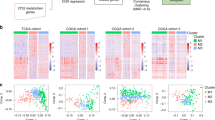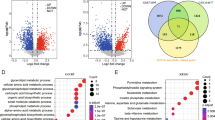Abstract
The aim of this study is to investigate the glucose metabolic status and its prognostic value in glioma. The Chinese Glioma Genome Atlas (CGGA), The Cancer Genome Atlas (TCGA), and GSE16011 datasets were used to develop the glucose-related signature. A cohort of 305 glioma samples with whole genome microarray expression data from the Chinese Glioma Genome Atlas database was included for discovery. TCGA and GSE16011 datasets were used for validation. Gene Set Enrichment Analysis (GSEA) and Cytoscape were used to explore the bioinformatic implication. GSEA revealed the biological process associated with the glucose-related signature. Cytoscape visualized the correlation analysis among the genes. We also collected the blood glucose information of patients with gliomas to analyze the association with tumor malignancy and patients’ survival. In this study, we identified that glucose-related gene sets could distinguish the clinical and molecular features of gliomas, involved in the malignancy of gliomas. And then, we developed a glucose-related prognostic signature for patients with glioblastoma in the CGGA dataset, validated in other additional public datasets. GSEA illustrated that tumor with higher risk score of glucose-related signature could correlate with cell cycle phase. In addition, blood glucose concentration was associated with the malignancy of glioma and the survival of patients. These results might provide new view for the research of glioma malignancy and individual treatment. Our research provided important resources for future dissection of glucose metabolic role in glioma.





Similar content being viewed by others
References
Louis DN, Perry A, Reifenberger G, von Deimling A, Figarella-Branger D, Cavenee WK, Ohgaki H, Wiestler OD et al (2016) The 2016 World Health Organization classification of tumors of the central nervous system: a summary. Acta Neuropathol. doi:10.1007/s00401-016-1545-1
Liu C-Y, Li Q-J, Cai J-Q (2016) Evolving molecular genetics of glioblastoma. Chin Med J 129(4):464. doi:10.4103/0366-6999.176065
Jiang T, Mao Y, Ma W, Mao Q, You Y, Yang X, Jiang C, Kang C et al (2016) CGCG clinical practice guidelines for the management of adult diffuse gliomas. Cancer Lett 375(2):263–273. doi:10.1016/j.canlet.2016.01.024
Seyfried TN, Flores R, Poff AM, D’Agostino DP, Mukherjee P (2015) Metabolic therapy: a new paradigm for managing malignant brain cancer. Cancer Lett 356(2 Pt A):289–300. doi:10.1016/j.canlet.2014.07.015
Derr RL, Ye X, Islas MU, Desideri S, Saudek CD, Grossman SA (2009) Association between hyperglycemia and survival in patients with newly diagnosed glioblastoma. Journal of Clinical Oncology : Official Journal of the American Society of Clinical Oncology 27(7):1082–1086. doi:10.1200/JCO.2008.19.1098
Warburg O (1956) On the origin of cancer cells. Science 123(3191):309–314
Champ CE, Palmer JD, Volek JS, Werner-Wasik M, Andrews DW, Evans JJ, Glass J, Kim L et al (2014) Targeting metabolism with a ketogenic diet during the treatment of glioblastoma multiforme. J Neuro-Oncol 117(1):125–131. doi:10.1007/s11060-014-1362-0
Cai J, Yang P, Zhang C, Zhang W, Liu Y, Bao Z, Liu X, Du W et al (2014) ATRX mRNA expression combined with IDH1/2 mutational status and Ki-67 expression refines the molecular classification of astrocytic tumors: evidence from the whole transcriptome sequencing of 169 samples samples. Oncotarget 5(9):2551–2561
Cai J, Zhang C, Zhang W, Wang G, Yao K, Wang Z, Li G, Qian Z et al (2016) ATRX, IDH1-R132H and Ki-67 immunohistochemistry as a classification scheme for astrocytic tumors. Oncoscience 3(7–8):258–265. doi:10.18632/oncoscience.317
Gravendeel LA, Kouwenhoven MC, Gevaert O, de Rooi JJ, Stubbs AP, Duijm JE, Daemen A, Bleeker FE et al (2009) Intrinsic gene expression profiles of gliomas are a better predictor of survival than histology. Cancer Res 69(23):9065–9072. doi:10.1158/0008-5472.CAN-09-2307
Brennan CW, Verhaak RG, McKenna A, Campos B, Noushmehr H, Salama SR, Zheng S, Chakravarty D et al (2013) The somatic genomic landscape of glioblastoma. Cell 155(2):462–477. doi:10.1016/j.cell.2013.09.034
Cancer Genome Atlas Research N (2015) Comprehensive, integrative genomic analysis of diffuse lower-grade gliomas. N Engl J Med. doi:10.1056/NEJMoa1402121
Mootha VK, Lindgren CM, Eriksson KF, Subramanian A, Sihag S, Lehar J, Puigserver P, Carlsson E et al (2003) PGC-1alpha-responsive genes involved in oxidative phosphorylation are coordinately downregulated in human diabetes. Nat Genet 34(3):267–273. doi:10.1038/ng1180
Subramanian A, Tamayo P, Mootha VK, Mukherjee S, Ebert BL, Gillette MA, Paulovich A, Pomeroy SL et al (2005) Gene set enrichment analysis: a knowledge-based approach for interpreting genome-wide expression profiles. Proc Natl Acad Sci U S A 102(43):15545–15550. doi:10.1073/pnas.0506580102
Cai J, Zhang W, Yang P, Wang Y, Li M, Zhang C, Wang Z, Hu H et al (2015) Identification of a 6-cytokine prognostic signature in patients with primary glioblastoma harboring M2 microglia/macrophage phenotype relevance. PLoS One 10(5):e0126022. doi:10.1371/journal.pone.0126022
Nduom EK, Wei J, Yaghi NK, Huang N, Kong LY, Gabrusiewicz K, Ling X, Zhou S et al (2015) PD-L1 expression and prognostic impact in glioblastoma. Neuro-Oncology. doi:10.1093/neuonc/nov172
Karpel-Massler G, Ramani D, Shu C, Halatsch ME, Westhoff MA, Bruce JN, Canoll P, Siegelin MD (2016) Metabolic reprogramming of glioblastoma cells by L-asparaginase sensitizes for apoptosis in vitro and in vivo. Oncotarget. doi:10.18632/oncotarget.9257
Sreekumar A, Poisson LM, Rajendiran TM, Khan AP, Cao Q, Yu J, Laxman B, Mehra R et al (2009) Metabolomic profiles delineate potential role for sarcosine in prostate cancer progression. Nature 457(7231):910–914. doi:10.1038/nature07762
Denkert C, Budczies J, Kind T, Weichert W, Tablack P, Sehouli J, Niesporek S, Konsgen D et al (2006) Mass spectrometry-based metabolic profiling reveals different metabolite patterns in invasive ovarian carcinomas and ovarian borderline tumors. Cancer Res 66(22):10795–10804. doi:10.1158/0008-5472.CAN-06-0755
Wang Y, Wang M, Wei W, Han D, Chen X, Hu Q, Yu T, Liu N et al (2016) Disruption of the EZH2/miRNA/beta-catenin signaling suppresses aerobic glycolysis in glioma. Oncotarget. doi:10.18632/oncotarget.10370
Han D, Wei W, Chen X, Zhang Y, Wang Y, Zhang J, Wang X, Yu T et al (2015) NF-kappaB/RelA-PKM2 mediates inhibition of glycolysis by fenofibrate in glioblastoma cells. Oncotarget 6(28):26119–26128. doi:10.18632/oncotarget.4444
Luan W, Wang Y, Chen X, Shi Y, Wang J, Zhang J, Qian J, Li R et al (2015) PKM2 promotes glucose metabolism and cell growth in gliomas through a mechanism involving a let-7a/c-Myc/hnRNPA1 feedback loop. Oncotarget 6(15):13006–13018. doi:10.18632/oncotarget.3514
Shibuya K, Okada M, Suzuki S, Seino M, Seino S, Takeda H, Kitanaka C (2015) Targeting the facilitative glucose transporter GLUT1 inhibits the self-renewal and tumor-initiating capacity of cancer stem cells. Oncotarget 6(2):651–661. doi:10.18632/oncotarget.2892
Liu Y, Li YM, Tian RF, Liu WP, Fei Z, Long QF, Wang XA, Zhang X (2009) The expression and significance of HIF-1alpha and GLUT-3 in glioma. Brain Res 1304:149–154. doi:10.1016/j.brainres.2009.09.083
Xu CF, Liu Y, Shen S, Zhu YH, Wang J (2015) Targeting glucose uptake with siRNA-based nanomedicine for cancer therapy. Biomaterials 51:1–11. doi:10.1016/j.biomaterials.2015.01.068
Zhang B, Dong LW, Tan YX, Zhang J, Pan YF, Yang C, Li MH, Ding ZW et al (2013) Asparagine synthetase is an independent predictor of surgical survival and a potential therapeutic target in hepatocellular carcinoma. Br J Cancer 109(1):14–23. doi:10.1038/bjc.2013.293
Panosyan EH, Wang Y, Xia P, Lee WN, Pak Y, Laks DR, Lin HJ, Moore TB et al (2014) Asparagine depletion potentiates the cytotoxic effect of chemotherapy against brain tumors. Molecular Cancer Research : MCR 12(5):694–702. doi:10.1158/1541-7786.mcr-13-0576
Wu W, Wu Q, Hong X, Zhou L, Zhang J, You L, Wang W, Wu H et al (2015) Catechol-O-methyltransferase, a new target for pancreatic cancer therapy. Cancer Sci 106(5):576–583. doi:10.1111/y12648
Acknowledgments
The authors conducting this work represent the Chinese Glioma Cooperative Group (CGCG).
Author information
Authors and Affiliations
Corresponding authors
Ethics declarations
The study protocol was approved by the ethics committees of participating hospitals, and all patients provided written informed consent.
Conflict of Interest
The authors declare that they have no conflict of interest.
Funding
Supported by grants from (1) The Research Special Fund For Public Welfare Industry of Heath (No. 201402008); (2) The National Key Research and Development Plan (No. 2016YFC0902500); (3) National Natural Science Foundation of China (No. 81572701, No. 81372700); (4) Special Fund Project of Translational Medicine in the Chinese-Russian Medical Research Center (No. CR201417); and (5) Research Project of Chinese Society of Neuro-oncology, CACA (CSNO-2014-MSD08).
Additional information
Shihong Zhao and Jinquan Cai contributed equally to this work.
Electronic supplementary material
Supplementary Figure S1
The consensus clustering for the gene expression profiling of 305 samples from the CGGA datasets based on the top 50 variable expression genes (MAD >1.0) when k was equal to 6 to 10. (TIFF 1610 kb)
Table S1
(DOCX 15 kb)
Table S2
(DOCX 13 kb)
Table S3
(DOCX 15 kb)
Table S4
(DOCX 13 kb)
Table S5
(DOCX 14 kb)
Rights and permissions
About this article
Cite this article
Zhao, S., Cai, J., Li, J. et al. Bioinformatic Profiling Identifies a Glucose-Related Risk Signature for the Malignancy of Glioma and the Survival of Patients. Mol Neurobiol 54, 8203–8210 (2017). https://doi.org/10.1007/s12035-016-0314-4
Received:
Accepted:
Published:
Issue Date:
DOI: https://doi.org/10.1007/s12035-016-0314-4




